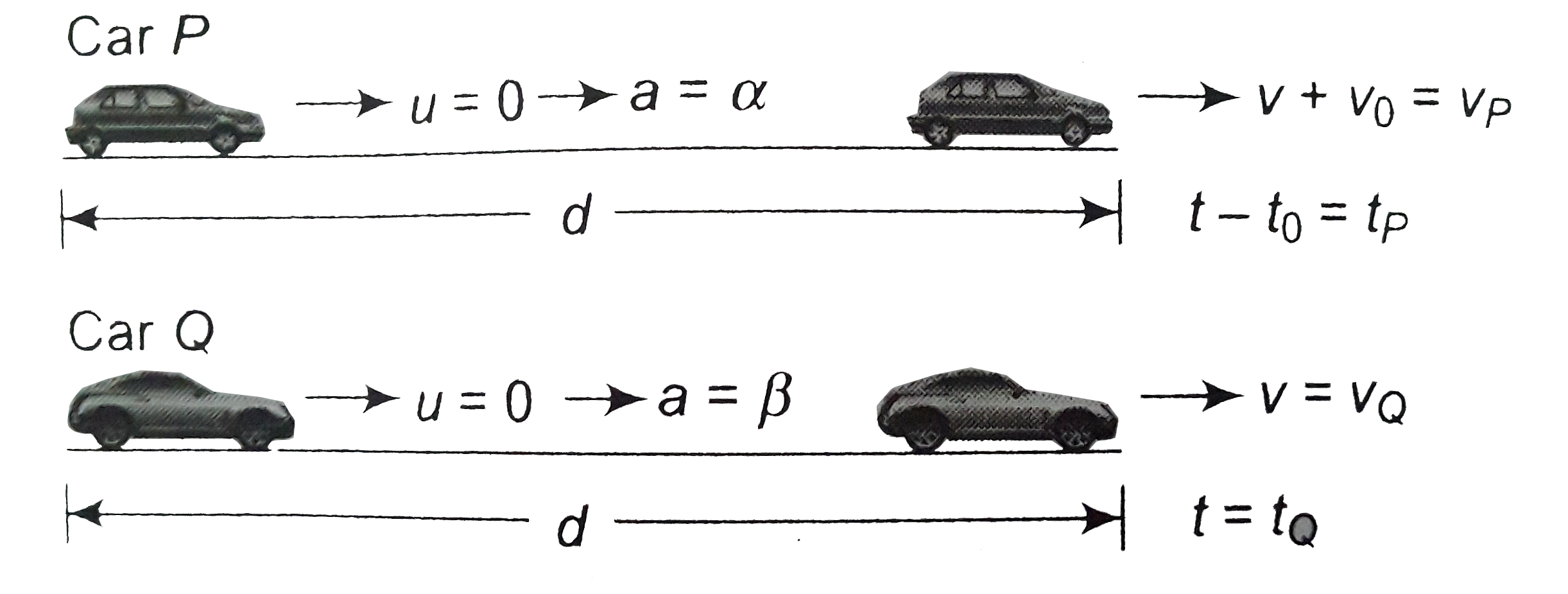In a car race, car A takes a time t less than car B at the finish and passes the finishing point with speed v more than that of the car B. Assuming that both the cars start from rest and travel with constant acceleration a1anda2 respectively. Show that v=√a1a2t.

vP−vQ=v0
tQ−tP=t0
vP−vQtQ−tP=√2αd−√2βd√2dβ−√2dα=v0t0
⎡⎢
⎢
⎢⎣Car P:d=12α2P⇒tP=√2dαv2P=2αd⇒vP=√2αdSimilarly for car Q.⎤⎥
⎥
⎥⎦
√α−√β1√β−1√α=√α−√β(√α−√β√αβ)=v0t0
v0=√αβt0
Topper's Solved these Questions
Similar Questions
In a car race, A takes a time of t s, less than car B at the finish and passes the finishin point with a velocity v more than car B. Assuming that the cars stat from rest and travel with constant accelerations a1 and a2. Respectively, show that v√a1a2t.
View SolutionIn a car race, car A takes 4s less than can B at the finish and passes the finishing point with a velcity v more than the car B . Assumung that the cars start form restand travel with constant accleration a1=4ms−2 and a2=1ms−2 respectively, find the velocity of v in m s−1.
View Solution
Knowledge Check
- Question 1 - Select One
In a car race, car A takes a timet less than car B at the finish and passes the finishing point with speed v more than that of the car B. Assuming that both the cars starts from rest and travel with constant accelerations a1 and a2 respectively. So, the value of v will be
A(√a1/a2)tB(√a2/a1)tC(a1√a2)tD(√a1a2)t - Question 2 - Select One
In a car race, car A takes t0 time less to finish than car B and passes the finishing point with a velocity v0 more than car B. The cars start from rest and travel with constant accelerations a1anda2. Then the ratio v0t0 is equal to.
Aa21a2Ba1+a22C√a1a2Da22a1 - Question 3 - Select One
In a car race, car P takes time t0 less than car Q and passes the finishing point with a speed v0 more than the speed with which xar Q passses the finishing point. Assume that both cars start from rest and trasvel with constant acceeleration α and β . Find v0 .
Av0=√α2−β22t0Bv0=(α+β2)t0Cv0=√αβt0Dv0=√α2+β22t0
A sports car is passing a police check post at 60kmh−1 , immediately started slowing down uniformly until its speed was 40kmh−1. It continued to move at the same speed until it was passed by a police car 1km from the check post. The police car had started from rest at the check post at the same instant as the sports car had passed the check post. The police car had moved with a constant acceleraation until it had passed sports car. Assuming that the time taken by the sports car in slowing down from 60kmh−1 to 40kmh−1 was equal to the time that it travelled at constant speed before passed by the police car, find
(a) the time taken by the police car to reach the sports car
(b) the speed of the police car at the instant when it passed the sports car
(c ) the time measured from the check post when the speeds of the two cars were equal.View SolutionIn a car race car A takes t0 time less to finish than car B and pases the finishing point with a velocity v0 more than car B. The cars start from rest and travel with constant accelerations a1 and a2 . Then the ratio v0t0 is equal to
View SolutionIn a car race, car A takes time t less than car B and passes the finishing point with a velocity of 12m/s more than the velocity with which car B passes the finishing point. Assume that the cars A and B start from rest and travel with constant acceleration of 9m/s2and 4m/s2 , respectively. If vA and vB be the velocities of cars A and B, respectively, then
View SolutionStarting from rest a particle is first accelerated for time t1 with constant acceleration a1 and then stops in time t2 with constant retardation a2. Let v1 be the average velocity in this case and s1 the total displacement. In the second case it is accelerating for the same time t1 with constant acceleration 2a1 and come to rest with constant retardation a2 in time t3. If v2 is the average velocity in this case and s2 the total displacement, then
View SolutionA constant power P is applied to a car starting from rest If v is the velocity of the car at time t,then
View Solution

